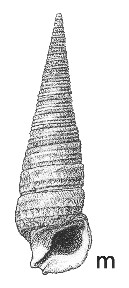
Revised descriptions of New Zealand Cenozoic Mollusca from Beu and Maxwell (1990)

 | Revised descriptions of New Zealand Cenozoic Mollusca from Beu and Maxwell (1990) | 
|
  (Pl. 36m): paratype, GS3528, R11/f7014, lower part of shellbed, Otahuhu Brewery well, Auckland, Waipipian (TM6771, GNS) |
Beu & Maxwell (1990): Chapter 14; p. 289; pl. 36 m.
Synonymy: Zefallacia lawsi Marwick 1948, p. 29
Classification: Cerithiidae
Description: Small for genus (40-42 mm high), tall and slender, with about 20-22 very short whorls with almost flat sides; spire outline slightly concave over upper half, slightly convex below. Early spire whorls with 3 prominent, narrow spiral cords, beaded by numerous low, closely spaced axial costae; over mid-height, whorls have 4 low, wide cords, posterior one widest and weakly beaded, others smooth; by eighteenth whorl sculpture becomes obsolete, leaving 2 or 3 very weakly defined, narrow spiral ridges and an unusual malleate appearance produced by weak oblique ridges over last 4 whorls. Protoconch of 3 smooth whorls, tall and narrow, with a protruding nucleus (similar to that of Zeacolpus). Aperture large, subquadrate; outer lip lightly thickened and slightly flared, with a wide shallow sinus on whorl side but swinging forward strongly over base, joining inner lip at top in a narrow, shallow, but well defined posterior canal margined by a parietal ridge; inner lip a wide, thick pad on last whorl, with base of columella protruding to form a low spiral fold; meeting base of outer lip at a short, deep, unnotched, weakly twisted anterior canal with no fasciole.
Comparison: The Paleogene and early Neogene species of Zefallacia are much larger and have more strongly shouldered whorls and so more stepped spire outlines than younger species. Z. ruamahanga (Tongaporutuan, northern Wairarapa) is similar in most characters to Z. lawsi, but is shorter and smoother. The only other Late Neogene species we are aware of is an unnamed one from Ngamatapouri, upper Waitotara Valley, Wanganui (Waipipian), which is shorter and more coarsely sculptured than Z. lawsi and Z. ruamahanga, retaining four spiral cords onto the last whorl. The genus is found only in estuarine and other very near-shore environments, on soft substrates, and apparently occupied a similar niche to the modern tropical "mangrove-creepers" Pyrazus and Terebralia.
Distribution: Waipipian; Otahuhu Brewery well, Auckland (type); not known from any other locality.
Cite this publication as: "A.G. Beu and J.I. Raine (2009). Revised
descriptions of New Zealand Cenozoic Mollusca from Beu and Maxwell (1990). GNS
Science miscellaneous series no. 27."
© GNS Science, 2009
ISBN
978-0-478-19705-1
ISSN 1177-2441
(Included with a PDF facsimile file
copy of New Zealand Geological Survey Paleontological Bulletin 58 in CD version
from: Publications Officer, GNS Science, P.O. Box 30368 Lower Hutt, New
Zealand)